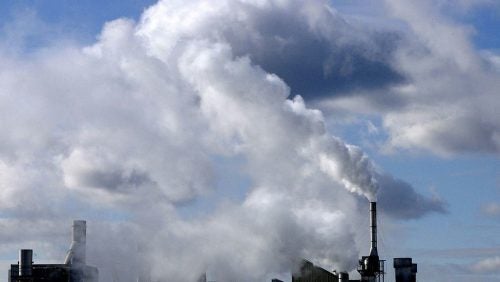Has Massachusetts v. EPA Hurt the Climate?
February 23, 2024 by Diego Huerta

Heavy industrial pollution leaving smokestacks in blue sky.
Massachusetts v. EPA is seen as an unalloyed victory for the climate movement, but over 15 years after the case was handed down, legal knock-on effects from the decision have come back to bite.
In 2007 the Supreme Court’s decision in Massachusetts v. EPA conclusively established that greenhouse gases qualify as air pollutants under the Clean Air Act.[1] This decision is widely lauded among climate change advocates because it allows the EPA to regulate greenhouse gas emissions, and because it serves as a strong affirmation of the importance of addressing global climate change. Unfortunately, the reality of greenhouse gas regulation following Massachusetts v. EPA has been bittersweet, for more reasons than one might think.
The best-known problem following Massachusetts v. EPA is that efforts to regulate greenhouse gases on the national and international level have still not been entirely successful. The EPA has delayed action to address climate change and, when it does act, their efforts have often been struck down in the courts.[2] International progress has also stagnated.[3] Of course, Massachusetts v. EPA isn’t responsible for every failure to address climate change, but the decision has played an important role in America’s response.
The potential downsides of Massachusetts v. EPA for the climate movement were discussed at the time that the case was argued. For example, in denying the rulemaking petition at issue in Massachusetts v. EPA, the EPA argued that unilateral climate action would make it harder to for the U.S. to negotiate climate agreements on the world stage, and that piecemeal approaches to climate change would be ineffective.[4] Additionally, Justice Scalia argued in his dissent that regulating carbon dioxide in the atmosphere was quite unlike the regulation of local air quality that EPA had previously been responsible for.[5] Though Scalia’s argument focused on the statutory interpretation question at issue in Massachusetts v. EPA, it could also be framed as a policy argument about the suitability of the Clean Air Act to address global atmospheric “pollution” problems. EPA’s policy arguments have held up better than arguments based in scientific uncertainty surrounding climate, though they have still been subject to criticism.[6] Whatever the merits of these arguments, regulation of greenhouse gases under the Clean Air Act is clearly no silver bullet.
Nevertheless, EPA has helped reduce some greenhouse gas emissions. One could argue that, despite imperfect results, Massachusetts v. EPA left the regulatory system better than what came before it, since before the decision there was no regulatory authority to address climate change.[7] But to make that point it is important to understand another knock-on effect of Massachusetts v. EPA. Specifically, that EPA’s power to regulate greenhouse gases forecloses otherroutes to abating greenhouse gas emissions under federal and state common law.
Federal common law is a rare version of common law that governs certain legal problems that require federal, and not state based, solutions.[8] Together, federal and state common law can both provide causes of action for harms caused by things that congress and/or state legislatures have not regulated.[9]
So, how does Massachusetts v. EPA foreclose common law claims? Through the doctrines of displacement and preemption. In American Electric Power v. Connecticut, the Supreme Court held that the EPA’s ability to regulate greenhouse gas emissions under the Clean Air Act, even if that ability is not used, displaces federal common law, meaning that courts cannot apply it.[10]
U.S. circuit courts have taken that reasoning one step further. In City of New York v. Chevron Corp., the Second Circuit found that state common law claims relating to climate change are preempted by federal common law due to the interstate nature of the issue, but also held that those federal common law claims are displaced by the Clean Air Act.[11]Of course, the court might have found preemption of state claims by federal common law whether or not the EPA had the right to regulate greenhouse gases, but in the absence of displacement the court would have been able to borrow from state standards in formulating federal common law.[12] Instead, Massachusetts v. EPA operates in concert with the doctrine of preemption to block state claims.
This doctrinal two-step leaves private parties with few, if any, viable legal routes to challenge greenhouse gas emissions using either federal or state common law.[13] Of course, it is far from clear that the loss of common law claims outweighs the value of EPA’s greenhouse gas regulations. But given the lackluster progress on climate change in the almost 17 years since Massachusetts v. EPA was decided, this problem is worth noting.
[1] See Massachusetts v. EPA., 549 U.S. 497, 535 (2007).
[2] See Cong. Rsch. Serv., R41561, EPA Regulations: Too Much, Too Little, or On Track? 8-14 (Dec. 30, 2016).
[3]See generally Taylor Kilduff, The Difficulties of Enforcing Global Environmental Law n. 3 (Feb. 1, 2019). https://www.law.georgetown.edu/environmental-law-review/blog/214/; United Nations Envtl. Programme, Environmental Rule of Law First Global Report (2019) (noting issues with international environmental agreements addressing greenhouse gas emissions).
[4] See 68 Fed. Reg. 52931
[5] See Massachusetts v. EPA, 549 U.S. 497, 558-600 (U.S., 2007) (Scalia, J., dissenting).
[6] See Kirsten Engel & Scott Sales, Subglobal Regulation of the Global Commons: The Case of Climate Change, 23 Ecology Law Quarterly 183 (2005) (arguing that imperfect regulation is better than no regulation at all).
[7] See id.
[8] See id.
[9] See id. at 422 (2011).
[10] See id. at 426.
[11] City of New York v. Chevron Corp., 993 F.3d 81, 91 (2d Cir. 2021).
[12] See Am. Elec. Power Co. v. Connecticut, 564 U.S. 410, 422 (2011).
[13] See generally Jonathan Adler, Displacement and Preemption of Climate Nuisance Claims, 17 J. of Law Economics and Policy 217 (2022).

